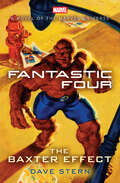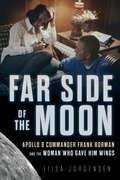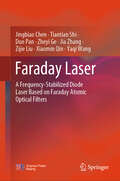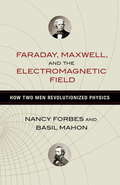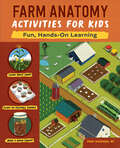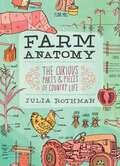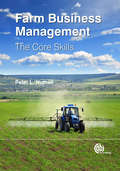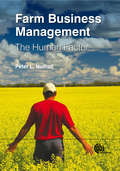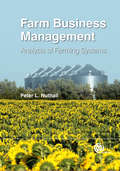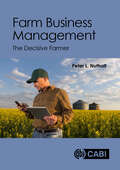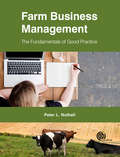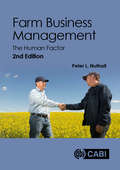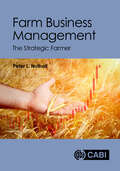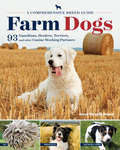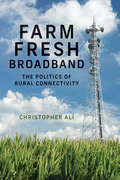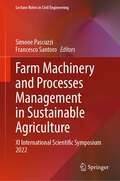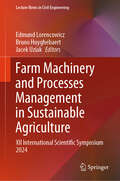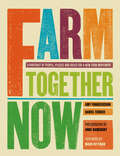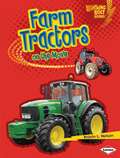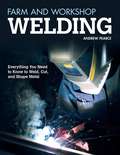- Table View
- List View
Fantastic Four: The Baxter Effect
by Dave SternMr. Fantastic&’s latest invention is turned against him and his family in this original Fantastic Four adventure novel. Quantum computing has long been a dream of computer scientists across the world. But now Reed Richards—Mr. Fantastic—has made it a reality. His quantum computer is infinitely more powerful than anything that has come before. It can predict the weather with unnerving accuracy and perform staggering calculations at lightning speed. Its potential for good is unmatched. But Mr. Fantastic knows all too well how scientific progress can have terrifying consequences. When an old enemy gets hold of his new invention, the Fantastic Four will face a threat unlike anything that has come before. As the group is pitted against itself, Ben Grimm—a.k.a. the Thing—will be forced to choose between the lives of those he loves and the survival of humanity . . .
Far Side of the Moon: Apollo 8 Commander Frank Borman and the Woman Who Gave Him Wings
by Liisa JorgensenThe decades-long love story of a NASA commander and the leader of the Astronaut Wives ClubFar Side of the Moon is the untold, fully authorized story of the lives of Frank and Susan Borman. One was a famous astronaut—an instrumental part of the Apollo space program—but the other was just as much a warrior. This real-life love story is far from a fairy tale. Life as a military wife was beyond demanding, but Susan always rose to the occasion. When Frank joined NASA and was selected to command the first mission to orbit the moon, that meant putting on a brave face for the world as her husband risked his life for the space race. The pressure and anxiety were overwhelming, and eventually Susan's well-hidden depression and alcoholism finally came to light. Frank had to come to terms with how his "mission above all else" mentality contributed to his wife's suffering. As Susan healed, she was able to begin helping others who suffered in silence from mental illness and addiction.Discover how Frank and Susan's love and commitment to each other is still overcoming life's challenges, even beyond their years as an Apollo commander and the founder of the Astronaut Wives Club.
Far Side of the Moon: The Story Of Apollo 11's Third Man
by Alex Irvine Ben Bishop*Junior Library Guild Selection 2017* A unanimous selection to the 2018 Maverick Graphic Novel List! This graphic retelling of the Apollo 11 moon-landing mission follows astronaut Michael Collins, commander of the lunar orbiter, to the far side of the moon. When the Earth disappears behind the moon, Collins loses contact with his fellow astronauts on the moon’s surface, with mission control at NASA, and with the entire human race, becoming more alone than any human being has ever been before. In total isolation for 21 hours, Collins awaits word that Neil Armstrong and Buzz Aldrin have managed to launch their moon lander successfully to return to the orbiter—a feat never accomplished before and rendered more problematic by the fuel burn of their difficult landing. In this singularly lonely and dramatic setting, Collins reviews the politics, science, and engineering that propelled the Apollo 11 mission across 239,000 miles of space to the moon. Fountas & Pinnell Level U <P><P> <i>Advisory: Bookshare has learned that this book offers only partial accessibility. We have kept it in the collection because it is useful for some of our members. Benetech is actively working on projects to improve accessibility issues such as these.</i>
Far-Field Optical Nanoscopy
by Philip Tinnefeld Christian Eggeling Stefan W. HellThis book describes developments in the field of super-resolution fluorescence microscopy or nanoscopy. In 11 chapters, distinguished scientists and leaders in their respective fields describe different nanoscopy approaches, various labeling technologies, and concrete applications. The topics covered include the principles and applications of the most popular nanoscopy techniques STED and (f)PALM/STORM, along with advances brought about by fluorescent proteins and organic dyes optimized for fluorescence nanoscopy. Furthermore, the photophysics of fluorescent labels is addressed, specifically for improving their photoswitching capabilities. Important applications are also discussed, such as the tracking and counting of molecules to determine acting forces in cells, and quantitative cellular imaging, respectively, as well as the mapping of chemical reaction centers at the nano-scale. The 2014 Chemistry Nobel Prize® was awarded for the ground-breaking developments of super-resolved fluorescence microscopy. In this book, which was co-edited by one of the prize winners, readers will find the most recent developments in this field.
Faraday Laser: A Frequency-Stabilized Diode Laser Based on Faraday Atomic Optical Filters
by Jia Zhang Yaqi Wang Jingbiao Chen Tiantian Shi Duo Pan Zheyi Ge Zijie Liu Xiaomin QinThis book systematically introduces the basic principles and technologies of Faraday lasers, starting from the development history and trends of diode lasers. High-precision frequency-stabilized diode lasers are essential instruments for frontier scientific research. They are the core components in the booming fields of quantum precision measurement, time-frequency communication, and atomic physics, and are of great significance to economic development and security construction. It elaborates on the significant advantages of Faraday lasers, based on the Faraday atomic optical filter, including their ability to automatically align with atomic transition lines during startup and their resistance to temperature and current disturbances. Additionally, the book covers the practical applications and significant value of Faraday lasers in devices such as cesium atomic clocks, atomic gravimeters, and underwater optical communication systems. It also explores the future development trends of Faraday lasers. This book is suitable for researchers and engineers in the field of frequency-stabilized diode lasers, and can also be used as a textbook for advanced undergraduate and graduate courses in quantum precision measurement, precision spectroscopy, and related fields. The basis of English translation of this book, originally in Chinese, was facilitated by artificial intelligence. The content was later revised by the authors for accuracy.
Faraday, Maxwell, and the Electromagnetic Field: How Two Men Revolutionized Physics
by Basil Mahon Nancy ForbesThe story of two brilliant nineteenth-century scientists who discovered the electromagnetic field, laying the groundwork for the amazing technological and theoretical breakthroughs of the twentieth centuryTwo of the boldest and most creative scientists of all time were Michael Faraday (1791-1867) and James Clerk Maxwell (1831-1879). This is the story of how these two men - separated in age by forty years - discovered the existence of the electromagnetic field and devised a radically new theory which overturned the strictly mechanical view of the world that had prevailed since Newton's time.The authors, veteran science writers with special expertise in physics and engineering, have created a lively narrative that interweaves rich biographical detail from each man's life with clear explanations of their scientific accomplishments. Faraday was an autodidact, who overcame class prejudice and a lack of mathematical training to become renowned for his acute powers of experimental observation, technological skills, and prodigious scientific imagination. James Clerk Maxwell was highly regarded as one of the most brilliant mathematical physicists of the age. He made an enormous number of advances in his own right. But when he translated Faraday's ideas into mathematical language, thus creating field theory, this unified framework of electricity, magnetism and light became the basis for much of later, 20th-century physics.Faraday's and Maxwell's collaborative efforts gave rise to many of the technological innovations we take for granted today - from electric power generation to television, and much more. Told with panache, warmth, and clarity, this captivating story of their greatest work - in which each played an equal part - and their inspiring lives will bring new appreciation to these giants of science.
Farm Anatomy Activities for Kids: Fun, Hands-On Learning (Anatomy Activities for Kids)
by Dawn AlexanderHelp kids ages 8 to 12 discover how awesome and fun farms can beNo matter where you live, you can learn all about the amazing things that happen on farms. Farm Anatomy Activities for Kids combines the joy of hands-on experiments and activities with easy-to-understand lessons that teach you all about farm life.This farm anatomy activity book helps you think more like a farmer and understand how nature, crops, and animals shape the way we live. You'll learn about all the different parts of a farm, the plants and animals you might find there, and how farms create the food you eat and the material for the clothes you wear.Farm Anatomy Activities for Kids includes:Educational lessons—Learn about the various parts of a farm, how they raise plants and animals, and the ways farms connect to your daily life no matter where you live.Ways to play—Try out cool experiments like growing crops without soil or making a mason bee house.Journal prompts—Reflect on what you've learned about farm anatomy with the thoughtful writing prompts paired with each activity.Take kids on an educational journey down to the farm without ever leaving home.
Farm Anatomy: The Curious Parts and Pieces of Country Life (Anatomy)
by Julia RothmanPopular illustrator Julia Rothman presents a colorfully entertaining visual tour of the parts of the farm and of the animals and activities found there, dissecting everything from cows, pigs, and roosters to the farmer&’s breakfast, crop rotation patterns, tractors and tools, and much, much more.
Farm Business Management
by Michael Thompson Peter Nuthall Patrick SkellyBased on research carried out within the farming community and academic studies, this book assesses and explains the core skills needed to become a successful farm manager. Observation, anticipation of plan outcomes, and risk management are identified as key requirements, and each of these categories is broken down into isolated skills such as problem definition and visual observation, which are in turn dissected and analysed. Practical methods for acquiring or improving each skill are covered in detail, with practice exercises to engage the reader in active participation. This book is an essential resource for farm managers and students.
Farm Business Management
by Peter NuthallThe underlying economic factors that effect primary production are frequently studied and written about - soil quality, animal health, climate, machinery - but this is the first book to explore the role of the psychology of the manager running the farm business, the person responsible for staff, strategic decisions and financial success or failure. The book will address fundamental questions such as the process of decision making, personal skills, and methods to improve managerial ability. It is an essential reference for farm managers and students in farm economics and management.
Farm Business Management
by Professor Peter L NuthallThe third and final instalment of Peter Nuthall's Farm Business Management series, this volume teaches the practical skills needed to manage a farm, such as risk analysis, budgeting, cost benefit analyses and much more. The key characteristic of this book is its ability to simplify the complex subject of business management into a clear, accessible volume tailored to the topic of farming, by using engaging techniques such as worked examples to fully explain the complex decision making tools necessary for this discipline.
Farm Business Management: The Decisive Farmer
by Peter L NuthallManagement research has shown successful farmers have quite distinct personal characteristics which most farmers have seldom thought about. Farmers who are less successful tend to have processes and systems which are likely to be biased. The aim of this book is to help all farmers discover more about these personal attributes that impinge on the success of their management, and to show how their attitudes and personal resources can be improved. This book is not a straightforward textbook. Rather, it tells the story of a group of farmers who take part in an expert-guided experiment designed to test approaches to improving management skill. The group meet at each other's farms to learn about their issues and develop solutions to improving what is called their 'management style' with the aim of removing any identified decision system biases. The book covers issues like optimal decision rule systems and how they can become second nature. Each chapter is devoted to one of the common issues defining management approaches. One chapter, for example, has the farmers sorting out issues around succession planning, another covers the vexed problem of farmer anxiety, and still another has the farmers learning skills on self-critiquing. Overall, there are fifteen chapters covering both general and specific issues. The book is designed for all farmers but is also a valuable resource for students of farm management and agribusiness. A strong learning feature of the book are the references to formal theories and explanations provided in addenda to each chapter. These cover and list the main teaching points highlighted in each farmer meeting giving details of where the detailed methods of solving each situation can be found. Exercises and case studies can also be accessed both on line and in other CABI books.
Farm Business Management: The Fundamentals of Good Practice
by Peter NuthallFarming is a complex job with many unique challenges, but can also be a rich and rewarding career that is full of opportunities. Following the author's Farm Business Management series, this new textbook takes the core principles and techniques and distils them into an accessible student resource. This book: covers the most important aspects of farm management, such as observation, decision making, budgeting, risk assessment and record keeping; is organized into easy-to-navigate sections such as the farmer's environment, financials, key skills and farm systems; and includes student-focused pedagogy throughout, comprising learning objectives, focus study exercises and review questions. Written by an expert with decades of teaching and research experience around the world, this book also incorporates two brand new chapters on farm accounting and computer systems and software. Providing a hands-on learning experience for students of agriculture, it will continue to be a much-used resource throughout their farming career. This book is enhanced with supplementary resources. Read chapter 1, and access free questions, tasks and lecture slides here.
Farm Business Management: The Fundamentals of Good Practice (Agriculture Ser.)
by Peter NuthallFarming is a complex job with many unique challenges, but can also be a rich and rewarding career that is full of opportunities. Following the author's Farm Business Management series, this new textbook takes the core principles and techniques and distils them into an accessible student resource. This book: covers the most important aspects of farm management, such as observation, decision making, budgeting, risk assessment and record keeping; is organized into easy-to-navigate sections such as the farmer's environment, financials, key skills and farm systems; and includes student-focused pedagogy throughout, comprising learning objectives, focus study exercises and review questions. Written by an expert with decades of teaching and research experience around the world, this book also incorporates two brand new chapters on farm accounting and computer systems and software. Providing a hands-on learning experience for students of agriculture, it will continue to be a much-used resource throughout their farming career. This book is enhanced with supplementary resources. Read chapter 1, and access free questions, tasks and lecture slides here.
Farm Business Management: The Human Factor (Agriculture Ser.)
by Peter L. NuthallThe underlying economic factors that affect primary production are frequently studied and written about―soil quality, animal health, climate, machinery―but this is the first book to explore the role of the decision psychology of the manager running the farm business, the person responsible for staff, strategic and operational decisions and the success or failure of financial and other objective outcomes. This second edition addresses fundamental questions such as the process of decision making, personal skills, and methods to improve managerial ability. It is an essential reference for farm managers and students in farm economics and management.
Farm Business Management: The Human Factor (Agriculture Ser.)
by Peter NuthallThe underlying economic factors that affect primary production are frequently studied and written about - soil quality, animal health, climate, machinery - but this is the first book to explore the role of the decision psychology of the manager running the farm business, the person responsible for staff, strategic and operational decisions and the success or failure of financial and other objective outcomes. This second edition addresses fundamental questions such as the process of decision making, personal skills, and methods to improve managerial ability. It is an essential reference for farm managers and students in farm economics and management. Key Features: This is the first farm business management book published worldwide focused on human factors and decision making in primary production The second edition introduces two new chapters covering the key decision method, intuition and its enhancement, and the importance of human characteristics in a range of decision topics and areas
Farm Business Management: The Strategic Farmer
by Peter L NuthallFarmers face ever-changing production systems, markets and regulations. This means they must constantly review their long-term plans to ensure continuing economic and environmental sustainability. The challenge for the future is for farmers to assess opportunities strategically as they appear and overcome the temptation of just meeting the demand of day-to-day tactical decision-making. This long-term view is the world of strategic planning. Farm owners and managers must constantly review the future and systematically assess likely future scenarios in order to make adjustments to suit prevailing needs. Any manager or owner thinking about purchasing a new farm business either to expand, or replace, an existing property must conduct similar assessments. This book addresses these issues and provides methods and procedures that enable the development and assessment of future strategies. This book explains how to be a "strategic farmer" in an unusual way. Rather like a novel, it tells the story of a newly reconstituted farming couple who are searching for a new property on which to carry out their primary production plans following their departure from a family farm which was being assigned to the next generation. In a previous book in this series (Farm Business Management: The Decisive Farmer), this same couple were involved in a team approach to improving decision-making. This book covers the couple's efforts to find a suitable property meeting all their strategic needs having analysed the expected future scenarios. In this process the couple interacts with many of their farmer friends and advisors who also featured as characters in the previous books. Each chapter is devoted to one of the common issues facing the modern farmer when trying to create a long-term strategic plan. To assess each issue, tried-and-tested strategic planning procedures are demonstrated with full explanations of their logic and methods. Each topic is fully referenced to provide further reading and discussion. Lecture guides, case studies and exercises are also provided online on the CABI Digital Library. This book is a valuable resource for all farmers and students of farm management and agribusiness.
Farm Dogs: A Comprehensive Breed Guide to 93 Guardians, Herders, Terriers, and Other Canine Working Partners
by Janet Vorwald DohnerGain a deeper understanding of your canine friends through these in-depth breed profiles that showcase how working dogs think. From familiar breeds like the Border Collie, Corgi, and Dachshund to the lesser-known Akbash, Puli, and Hovawart, Janet Vorwald Dohner describes 93 breeds of livestock guardian dogs, herding dogs, terriers, and traditional multipurpose farm dogs, highlighting the tasks each dog is best suited for and describing its physical characteristics and temperament. She also offers an accessible history of how humans bred dogs to become our partners in work and beyond, providing a thorough introduction to these highly intelligent, independent, and energetic breeds.
Farm Fresh Broadband: The Politics of Rural Connectivity (Information Policy)
by Christopher AliAn analysis of the failure of U.S. broadband policy to solve the rural–urban digital divide, with a proposal for a new national rural broadband plan.As much of daily life migrates online, broadband—high-speed internet connectivity—has become a necessity. The widespread lack of broadband in rural America has created a stark urban–rural digital divide. In Farm Fresh Broadband, Christopher Ali analyzes the promise and the failure of national rural broadband policy in the United States and proposes a new national broadband plan. He examines how broadband policies are enacted and implemented, explores business models for broadband providers, surveys the technologies of rural broadband, and offers case studies of broadband use in the rural Midwest. Ali argues that rural broadband policy is both broken and incomplete: broken because it lacks coordinated federal leadership and incomplete because it fails to recognize the important roles of communities, cooperatives, and local providers in broadband access. For example, existing policies favor large telecommunication companies, crowding out smaller, nimbler providers. Lack of competition drives prices up—rural broadband can cost 37 percent more than urban broadband. The federal government subsidizes rural broadband by approximately $6 billion. Where does the money go? Ali proposes democratizing policy architecture for rural broadband, modeling it after the wiring of rural America for electricity and telephony. Subsidies should be equalized, not just going to big companies. The result would be a multistakeholder system, guided by thoughtful public policy and funded by public and private support.
Farm Machinery and Processes Management in Sustainable Agriculture: XI International Scientific Symposium 2022 (Lecture Notes in Civil Engineering #289)
by Simone Pascuzzi Francesco SantoroThis volume gathers the latest advances, innovations, and applications in the field of sustainable and smart agriculture, as presented by leading researchers at the XI Farm Machinery and Processes Management in Sustainable Agriculture (FMPMSA), held in Bari, Italy on June 13-15, 2022. The volume covers highly diverse topics, including: management of field and livestock production machinery; management of biomass and agroenergy production; plant protection, soil management and agrochemicals application; smart farming and sustainability; ergonomic, labour organization, pandemic impact; sustainable agriculture in the European Union and other countries. The papers, which are published after a rigorous international peer-review process, highlight numerous exciting ideas that will spur novel research directions and foster multidisciplinary collaboration among different specialists.
Farm Machinery and Processes Management in Sustainable Agriculture: XII International Scientific Symposium 2024 (Lecture Notes in Civil Engineering #609)
by Edmund Lorencowicz Bruno Huyghebaert Jacek UziakThis book gathers the latest advances, innovations, and applications in the field of sustainable and smart agriculture, as presented by leading researchers at the XII Farm Machinery and Processes Management in Sustainable Agriculture (FMPMSA), held in Lublin, Poland, on June 12–14, 2024. The book covers highly diverse topics, including: management of field and livestock production machinery; management of biomass and agroenergy production; plant protection, soil management and agrochemicals application; smart farming and sustainability; ergonomic, labor organization; and sustainable agriculture in the European Union and other countries. The papers, which are published after a rigorous international peer-review process, highlight numerous exciting ideas that will spur novel research directions and foster multidisciplinary collaboration among different specialists.
Farm Together Now
by Amy Franseschini Daniel TuckeyThe story of the sustainable farming movement, with numerous photos: “Inspirational, informational . . . a glimpse of what the future of food may well look like.” —TreehuggerWith interest in home gardening at an all-time high and concerns about food production and safety making headlines, Farm Together Now explores the current state of grassroots farming in the United States. Part oral history and part treatise on food politics, this fascinating project is an introduction to the many individuals who are producing sustainable food, challenging public policy, and developing community organizing efforts. With hundreds of photographs and a foreword from New York Times columnist Mark Bittman, Farm Together Now will educate, inspire, and cultivate a new wave of modern agrarians.
Farm Tractors on the Move (Lightning Bolt Books)
by Kristin L. NelsonIt drives through dirt and mud. It pulls heavy machines through fields. This farm tractor is on the move! What jobs do tractors do? And how do farmers drive tractors
Farm and Workshop Welding: Everything You Need to Know to Weld, Cut, and Shape Metal
by Andrew PearceAlmost anyone can learn to weld, cut or shape metal. That's the starting point for this supremely practical, comprehensive handbook which, through tips, suggestions and fault finding, helps the beginner to improve and the intermediate operator to broaden his or her technique. The ideal reference for farm, home workshop, school workshop, blacksmith shop, and auto shop, Farm and Workshop Welding even takes you beyond welding metals and plastics, with advice that extends into the wider workshop with chapters on drills, cutting threads, and basic blacksmithing. Author Andrew Pearce lays out pitfalls and common mistakes section by section, and then offers constructive advice to help you to avoid or correct them. Useful if you're stumped by a problem! Hundreds of step-by-step photographs illustrate welding processes and show the differences between good welds and bad welds. Clear, concise, easy-to-understand text takes any confusion or frustration out of learning the processes. Whether you're a complete beginner or an experienced welder who wants to learn more, Farm and Workshop Welding provides a wealth of useful shop-tested advice. You'll discover everything you need to know to learn hands-on welding, and start repairing and creating metal equipment and structures.
